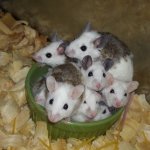Most of mine are colored like yours, with a little more brown saddle. I do have some from the breeder's solid brown male that turned out brown with a stripe down the head and stripes across each cheek. I have one female that's solid brown with pink ears. All the rest have brown ears. I kept one solid colored brown male just to get a variety.
For those members who don't have ASF's yet, they seem docile during the day and move around a little, but when the lights go out all hell breaks loose. Mine run around, climb on the bars of my lab breeder cages, do back flips, and in general try to escape.
They cam jump, so you need to be careful cleaning the cages. I clean mine during the day when they are mostly at rest. If I tried at night I'd probably have them all over the house.
I have read that some states prohibit selling them across state lines, but since they aren't shipped I don't know how that could be enforced.
For those members who don't have ASF's yet, they seem docile during the day and move around a little, but when the lights go out all hell breaks loose. Mine run around, climb on the bars of my lab breeder cages, do back flips, and in general try to escape.
They cam jump, so you need to be careful cleaning the cages. I clean mine during the day when they are mostly at rest. If I tried at night I'd probably have them all over the house.
I have read that some states prohibit selling them across state lines, but since they aren't shipped I don't know how that could be enforced.

